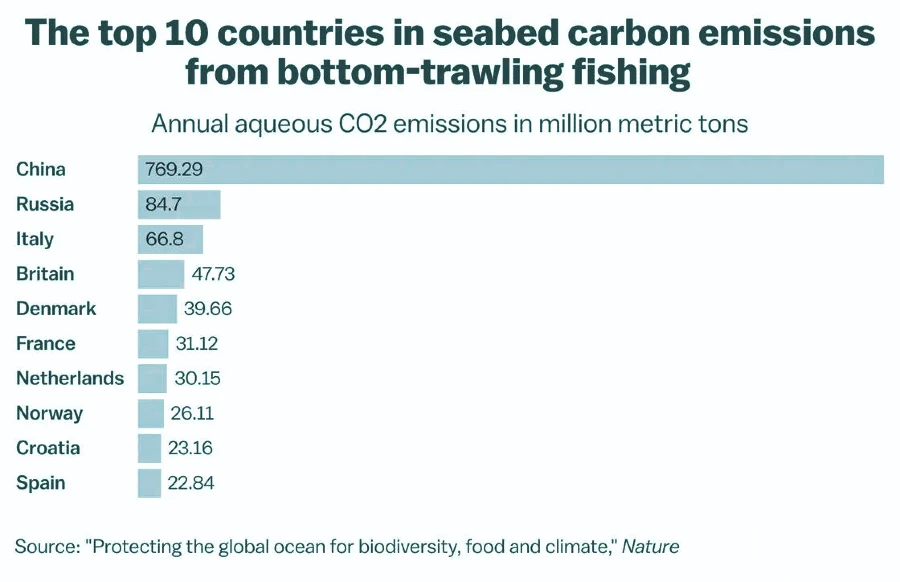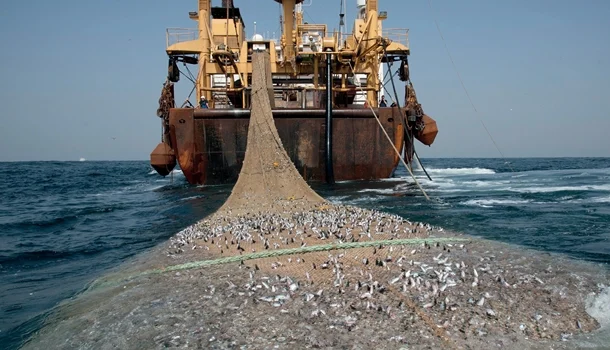In a recent report, scientists have pinpointed a significant yet overlooked source of carbon emissions: bottom trawling.
This fishing practice, which involves dragging heavy nets across the ocean floor, is destructive to marine ecosystems and is a major contributor to atmospheric carbon dioxide levels. Turns out, bottom trawling releases an estimated 370 million metric tons annually. That’s double the emissions attributed to the global fishing fleet’s fuel consumption.
As the de facto, global leader in bottom trawling, China plays a very prominent role in this problem.

Bottom Trawling
The process of bottom trawling has long been controversial due to its devastating impact on ocean habitats, but the damage it does to the atmosphere is new information. It’s exacerbating climate change by disturbing ocean sediments and releasing trapped carbon dioxide into the atmosphere.
The study, a collaborative effort including Utah State University, NASA Goddard Institute for Space Studies, the University of California Santa Barbara, Columbia University, James Cook University, and National Geographic Pristine Seas, has really opened a new depth of understanding the full environmental cost of this practice. Will this evidence force entire nations, primarily China, to change their ways? Probably not.
Dr. Trisha Atwood from Utah State University starkly compared the damage caused by bottom trawling to the destruction of forests, emphasizing the dual threat it poses to both climate and marine biodiversity. “Dragging heavy fishing nets across the ocean floor destroys sea life and habitats,” she explained, highlighting the newfound realization that this activity also liberates carbon plumes that were otherwise securely stored in the seabed.

Identifying Emission Hotspots Globally
The research identifies critical regions where bottom trawling emissions are particularly high, such as the East China Sea, the Baltic Sea, the North Sea, and the Greenland Sea. These areas, alongside others like Southeast Asia and the Gulf of Mexico, represent significant hotspots of carbon release due to the intensity of trawling activities.
The study’s findings are alarming, with the levels of emissions rivaling entire countries. In fact, the trawling industry releases more carbon into the atmosphere than even the entire global aviation industry.
The Call for Immediate Action
The implications of this study are clear: bottom trawling is a critical front in the fight against climate change that cannot be ignored. Dr. Enric Sala, National Geographic Explorer in Residence, stressed the absence of bottom trawling emissions in current climate action plans and underscored the necessity of addressing ocean emissions to mitigate global warming effectively. “Reducing bottom-trawling carbon emissions will deliver immediate benefits,” Sala asserted, warning against the repercussions of inaction.
Furthermore, the study delves into the fate of the carbon that remains in the ocean post-trawling, revealing that a significant portion leads to increased water acidity. This change in the ocean’s chemistry further endangers marine life, adding another layer of urgency to address the issue.
More To Discover
- Iceland Unveils World’s Largest ‘Climate Vacuum’ to Tackle Atmospheric Carbon
- Plastic Recycling Directory Shuts Down Because Industry Isn’t Committed
- Western Fusion Visionaries Gather in D.C. Amid Growing Competition with China
- Vanuatu Stops Chinese Logging Firm Amid Theft Claims and Workers In Chinese Military Uniforms
The revelation about bottom trawling’s role in climate change opens the door for policy changes aimed at minimizing its environmental impact. Gavin A. Schmidt, Director of the NASA Goddard Institute for Space Studies, likened the practice to “marine deforestation,” calling for comprehensive policy efforts that balance the various impacts of bottom trawling.
Source: Nature



















